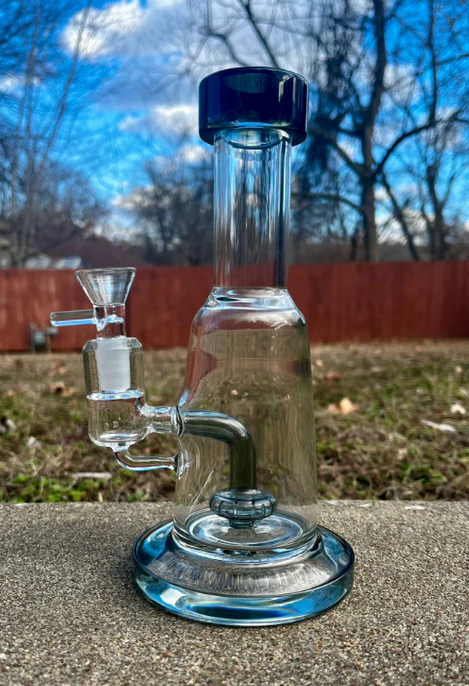When it comes to consuming cannabis, the debate between smoking and dabbing is a hot topic. Both methods offer unique advantages and potential drawbacks, but which one is truly safer for your health? Let’s explore the details and determine the best choice for your lifestyle.

Smoking Versus Dabbing
Smoking involves burning cannabis flowers and inhaling the smoke through various methods such as joints, blunts, pipes, and bongs. This traditional method releases cannabinoids through combustion.
Dabbing involves vaporizing concentrated cannabis extracts like wax, shatter, and oil using a dab rig and a dab torch. The concentrate is applied to a heated nail, producing a vapor that is then inhaled.
Which Is the Safer Option?
Combustion and Toxins
- Smoking: The process of combustion releases harmful byproducts like tar and carcinogens, which can negatively impact lung health over time. Regular smoking can lead to respiratory issues, including chronic bronchitis and lung irritation.
- Dabbing: Vaporization, on the other hand, produces fewer toxins and carcinogens compared to smoking. This can make dabbing a potentially safer option for your lungs, as it reduces exposure to harmful byproducts.
Potency and Dosage Control
- Smoking: This method allows for more dosage control due to the lower concentration of cannabinoids. Users can consume more cannabis to achieve desired effects gradually, which can be beneficial for those who prefer milder experiences.
- Dabbing: Dabbing offers a much higher potency, meaning you can achieve the desired effects with smaller amounts. However, the high concentration of cannabinoids can also lead to overconsumption, particularly for beginners who are not accustomed to such strong effects.
Health Impact
- Smoking: Combustion of plant material produces a range of harmful byproducts, including tar and carcinogens. These substances can lead to respiratory issues, chronic bronchitis, and a higher risk of lung infections. Over time, frequent smoking can also contribute to decreased lung function.
- Dabbing: While dabbing avoids the harmful byproducts of combustion, it is not entirely risk-free. Poor-quality concentrates can contain residual solvents or contaminants that may pose health risks. Additionally, the high potency of dabs can increase the likelihood of developing a high tolerance or dependence on cannabis.
Risks of Dabbing
While dabbing has several benefits, it also comes with certain risks that users should be aware of:
- High Potency: The intense effects of dabbing can be overwhelming and sometimes uncomfortable, especially for inexperienced users. It is easier to consume too much, which can lead to adverse effects such as paranoia and extreme drowsiness.
- Equipment and Safety: Using a dab rig and torch requires proper handling and caution. The high temperatures involved in heating the nail can pose safety risks, including burns and fires if not managed correctly.
- Quality of Concentrates: Poorly made concentrates may contain residual solvents and contaminants, posing additional health risks. It’s crucial to ensure that the concentrates are sourced from reputable producers who use proper extraction methods.
Discretion
Smoking cannabis is quite noticeable due to the distinct smell and the production of smoke. It’s not the most discreet method, and the odor can linger on clothing and in the environment, making it obvious to others that you have been smoking.
Dabbing, however, produces vapor instead of smoke, which tends to dissipate more quickly and leaves less lingering odor. This can make dabbing a more discreet option for those who prefer to keep their consumption private. The reduced smell and visible vapor make it easier to use without attracting attention.
Efficiency and Cost
Smoking typically requires a larger amount of cannabis flower to achieve the desired effects. This can be less efficient and more costly in the long run, especially for frequent users who need to purchase more flowers regularly.
Dabbing allows users to achieve potent effects with smaller amounts of concentrate, making it a more efficient method. However, the initial cost of purchasing a dab rig and other necessary equipment can be higher compared to traditional smoking tools. Once the equipment is acquired, the ongoing cost of concentrates might be lower compared to the frequent purchase of cannabis flowers.
Duration of Effects
- Smoking: The effects of smoking cannabis typically come on quickly and can last anywhere from one to three hours, depending on the strain and individual tolerance. This allows users to gauge their level of intoxication and consume more as needed.
- Dabbing: The effects of dabbing are also felt almost immediately but are often much stronger and can last longer than smoking. This can be advantageous for those seeking prolonged relief from symptoms, but it also means that overconsumption can lead to extended periods of discomfort.
Final Thoughts
Both smoking and dabbing offer unique benefits and potential risks. Dabbing provides a cleaner, more potent experience with fewer harmful byproducts, making it potentially safer for your lungs. However, the high potency and complexity of equipment usage require caution and experience. Smoking, while more traditional and easier to control dosage, exposes users to more harmful byproducts and can be less discreet.
Your choice between smoking and dabbing ultimately depends on your personal needs, preferences, and health considerations. Whether you prioritize potency, discretion, or ease of use, it’s essential to consume cannabis responsibly and be mindful of how your body reacts to different methods. Always source your cannabis products from reputable suppliers to ensure quality and safety.
